 Move How to Use the Docs
Move How to Use the Docs
Open How to Use the Docs
Welcome to Quepid!
You are on your way to better search quality.
Ready to get deeper with Quepid? There are many ways of building your Quepid "qompetency", so the documentation is built around trying to meet you where you are.
The docs are organized in four quadrants using the Diátaxis framework:
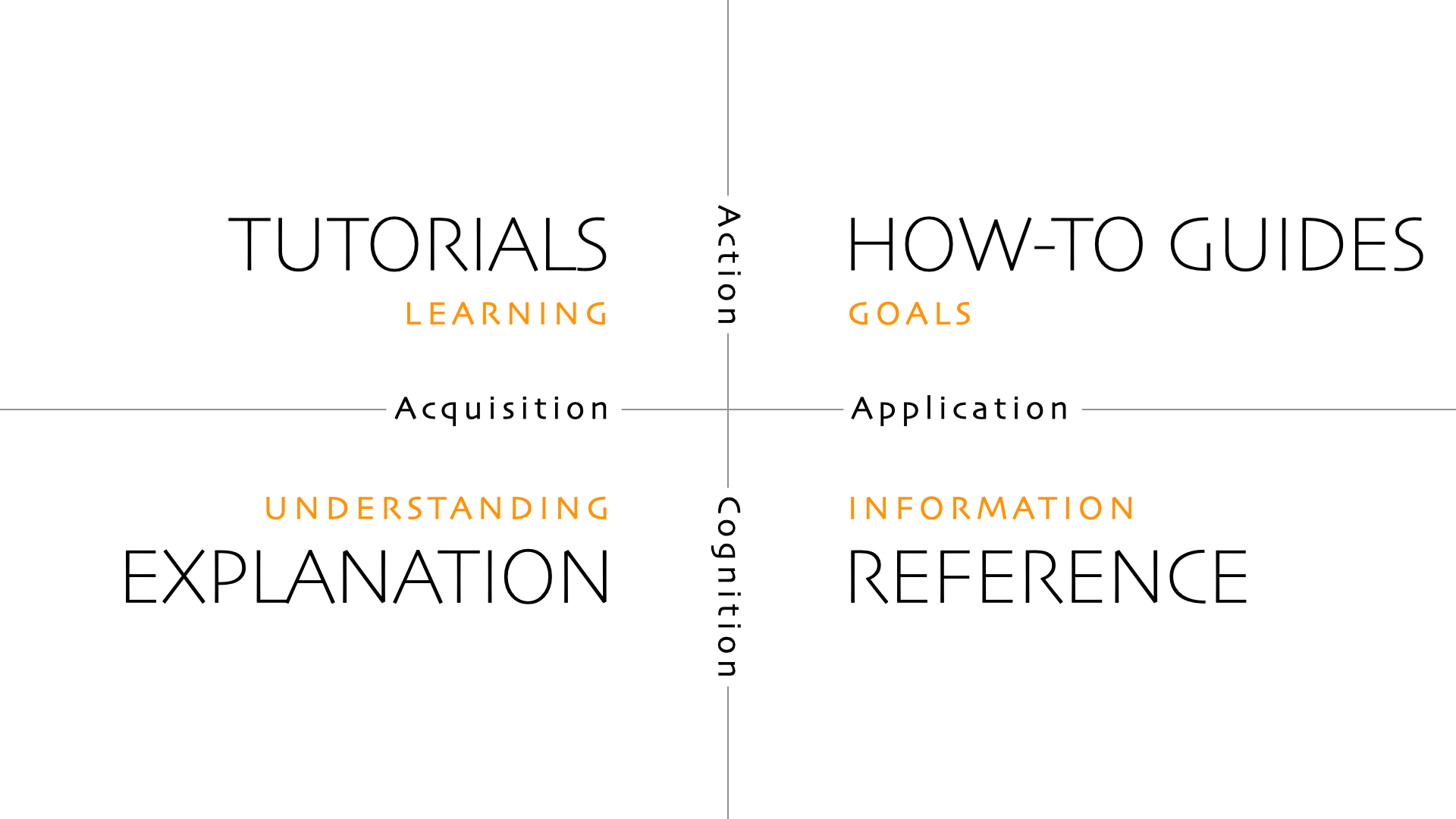
Each Quadrant in listed as a separate chapter. We start with the Tutorials and How-To Guides first, and then have the deeper Explanation and Reference sections.
Many of these pages will link out to other locations that have more details.
Want to contribute to the docs? Ping Eric at epugh@opensourceconnections.com for a invite to become a writer.
How to Use the Docs
111 words
 Move What is Quepid?
Move What is Quepid?
Open What is Quepid?
What is Quepid?
Before we go furthur, what exactly is Quepid? Quepid is a tool to help you improve your organization's search results. It is a web-based application and can either be used at https://go.quepidapp.com or it can be installed on your own hardware. Quepid makes improving your app's search results a repeatable, reliable engineering process that the whole team can understand
Did you know?
Did you know? Quepid is an open source project open to everyone! If you have a passion for helping others improve search relevance visit the project on GitHub to learn how to contribute.
Quepid was created and designed to address three pain-points often experienced during search relevancy improvement:
- Collaboration - Our collaboration stinks! Making holistic progress on search requires deep, cross-functional collaboration. Sending emails between teams or tracking search requirements in spreadsheets won't provide the improv
What is Quepid?
379 words
 Move Structure of Tutorials
Move Structure of Tutorials
Open Structure of Tutorials
Structure of Tutorials
These tutorials are set up to guide you through learning Quepid. Pick the ones that map to your specific role.
The tutorials assume you are using the hosted version of Quepid at https://go.quepidapp.com.
I am a Relevance Engineer
I am a Judge who needs to Rate Documents
I am an Ops Person Setting up Quepid
Structure of Tutorials
96 words
 Move Setting Up Your First Case
Move Setting Up Your First Case
Open Setting Up Your First Case
Setting Up Your First Case
The first time you sign up on Quepid you will be prompted with a big blue button to Create Your First Relevancy Case.
A Case refers to all of the queries and relevance tuning settings for a single search engine. For example, if we are running a movie rental store and we want to improve our "Star Wars" search results, we may create a new case and call it "star wars." Under this case we will perform our searches and provide our judgments.
Creating a New Case
Click the Create Your First Relevancy Case. If you don't see it, then click the Relevancy Cases menu at the top and click Create a case.
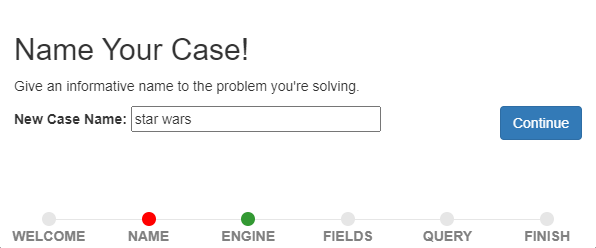
The first piece of information we are asked to provide is a name for the Case. Enter "star wars" and click Continue.
Now, we need to set up the connection to the Search Endpoint. We're going to use a publicly hosted Solr search engine as our Search Endpoint. Click t
Setting Up Your First Case
974 words
 Move Tuning Relevance
Move Tuning Relevance
Open Tuning Relevance
Tuning Relevance
This tutorial assumes you have have finished the Setting Up Your First Case tutorial. It is split into two sections: Creating Judgements and then Tuning Relevance.
Creating Judgments
In order to do relevancy tuning, you must have some judgements available to you to evaluate your search quality against.
While you can judge documents right in a Case, in general it's better to use a Book to manage the judgements and let Subject Matter Experts or Expert Users do the judging work!
Making Binary Judgements
Let's start with the star wars query by clicking it. The list of movies matching the star wars query will be shown. To the left of each movie search result is a gray box. We use this box provide a relevance judgment for each movie. Click the Select Scorer link and click P@10. This allows us to make a binary judgment on each search result and label each as either relevant (1) or not relevant (0). Now, for each search result, look at the fields returned (that we
Tuning Relevance
1,580 words
 Move Relevancy is a Team Sport
Move Relevancy is a Team Sport
Open Relevancy is a Team Sport
Collaborative Judgements - Relevancy is a Team Sport
This tutorial assumes you have completed the previous tutorial, Tuning Relevance, and have set up a case with queries available. Here, we will guide you through setting up a collaborative environment to collect judgements from human raters.
Why Collaborative Judgements?
In Tuning Relevance, we created judgements in the role of relevance engineers: We followed our intuition to classify a result as relevant or irrelevant. This method works well for small-scale projects, like rating the top 10 results for a few queries. However, for larger projects, this approach can introduce biases and become inefficient.
By involving a team of human raters, we can scale up and improve the quality of judgements. Human raters evaluate query/document pairs by considering the information need of the query.
Information Needs
An Information Need is a conscious or unconscious desire for in
Relevancy is a Team Sport
803 words
 Move Quepid for Human Raters
Move Quepid for Human Raters
Open Quepid for Human Raters
This tutorial builds on the previous one, Collaborative Judgements, and assumes you have already set up a book with query/document pairs ready for evaluation. In this guide, we will explore the Human Rating Interface, which is designed to streamline the process of assigning judgements to query/document pairs.
The role of a human rater is accessible to anyone with the right task description. No technical background is required—just the ability to assess how well a document matches the information need for a given query.
Overview of the Human Rating Interface
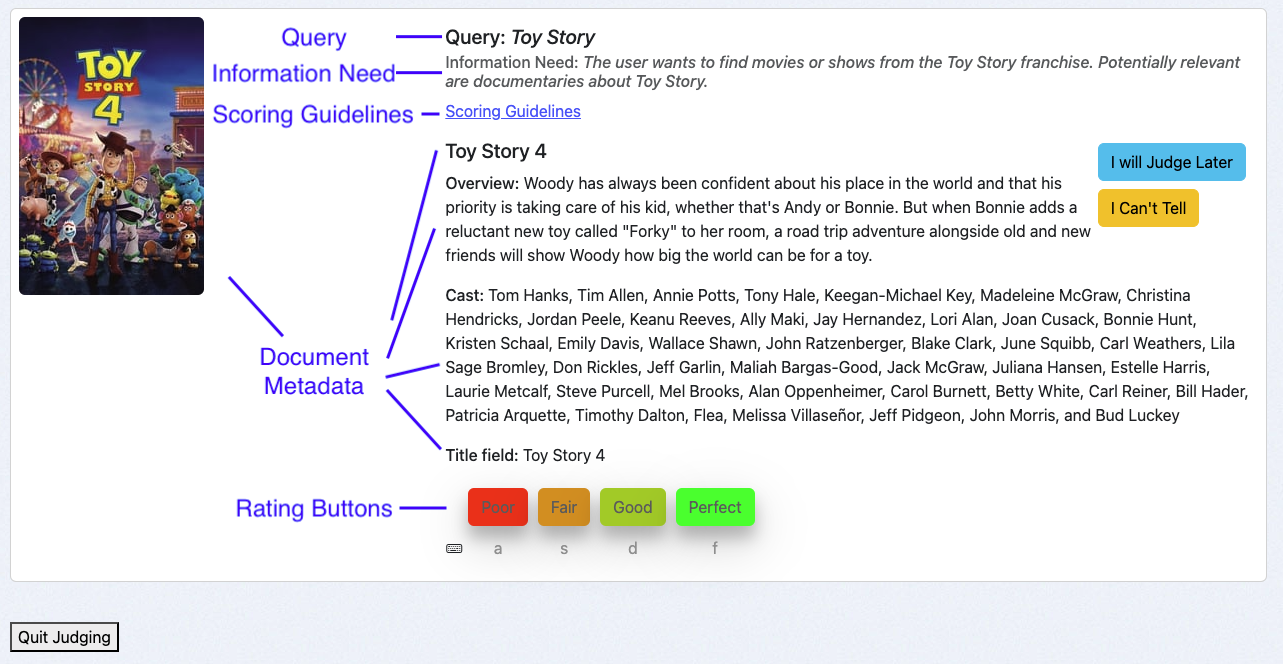
The Human Rating Interface is thoughtfully structured to assist raters in providing accurate and consistent judgements. The interface consists of the following key components:
- Query: Displays the query associated with the query/document pair being evaluated.
- Information Need: Highlights the
Quepid for Human Raters
679 words
 Move How to Deploy Quepid Locally
Move How to Deploy Quepid Locally
Open How to Deploy Quepid Locally
How to Deploy Quepid Locally
This is for 8.2.1 or later
Standing up Quepid locally when you have Docker is very simple. You only need to grab a Docker Compose template from the Quepid Github repo:
curl https://raw.githubusercontent.com/o19s/quepid/refs/heads/main/deployment/quepid-docker-deploy/docker-compose.yml > docker-compose.yml
Update docker-compose.yml to set the version of Quepid (like o19s/quepid:8.2.0) that you want to run. See https://hub.docker.com/r/o19s/quepid/tags for a list of all the released versions of Quepid!.
Start Quepid: docker compose up, append -d to have it run as a background process.
Go to http://localhost and register your user.
Grant your user admin permissions via: docker compose exec app bundle exec thor user:grant_administrator EMAIL
To stop Quepid run docker compose down.
Your data is stored in MySQL in the ./volumes/myssql_data directory between usages.
How to Deploy Quepid Locally
131 words
 Move How to Deploy Quepid on Digital Ocean
How to Deploy Quepid on Digital Ocean
35 words
Move How to Deploy Quepid on Digital Ocean
How to Deploy Quepid on Digital Ocean
35 words
 Move How to Configure Login Options
Move How to Configure Login Options
Open How to Configure Login Options
How to Configure Login Options
You can log into Quepid in a number of ways, including with email/password, or using oAuth providers like Google Auth or Keycloak.
Disabling Email/Password Sign In
By default .env file contains:
# Whether or not signing in via email/password is enabled.
EMAIL_SIGNIN_ENABLED=true
Setting it to false prevents you from being able to sign in using an email/password combination.
OAuth
Quepid uses OmniAuth for authenticating users against other resources besides it's own email/password database. OmniAuth provides an easy way to authenticate against dozens of outside services. The only ones that are packaged with Quepid are Google and Keycloak, but it's fairly easy to add new ones.
Learn more about setting up Google oAuth at https://support.google.com/cloud/answer/6158849?hl=en.
The built in options are GOOGLE_CLIENT_ID, GOOGLE_CLIENT_SECRET, KEYCLOAK_REALM and KEYCLOAK_SITE.
The OmniA
How to Configure Login Options
283 words
 Move How to Configure Sign Up Options
Move How to Configure Sign Up Options
Open How to Configure Sign Up Options
How to Configure Sign Up Options
In some environments we want to preload the users and only allow those users access to Quepid. This could be applicable to environments with sensitive data like that containing PII. We would not want to allow just anyone to sign up.
By default .env file contains:
# Whether or not signing up via the UI is enabled.
SIGNUP_ENABLED=true
Setting it to false prevents you from being able to create an account via the UI.
Instead, an administrator needs to load the user accounts directly into Quepid by using the Thor command line tool. See Quepid Admin CLI in Reference section.
How to Configure Sign Up Options
109 words
 Move How to Add a Recency Scorer
Move How to Add a Recency Scorer
Open How to Add a Recency Scorer
How to Add a Recency Scorer
A Recency Scorer lets you understand the average age of the content you are returning.
- Go to the Scorers page and choose
Add New to create the new Scorer.
- Give it a meaningful name like Recency or Age of Product that works for you.
- For the actual JavaScript code, start with this basic scorer:
const k = 10; // @Rank
let rank = 0;
let score = 0;
baseDate = new Date("2023-08-15").getTime();
eachDoc(function(doc, i) {
docDate = doc['publish_date'];
const diffTime = (baseDate - new Date(docDate).getTime());
const diff = Math.ceil(diffTime / (1000 * 60 * 60 * 24));
score = score + diff;
rank = rank + 1
}, k);
score = rank > 0 ? score / rank : 0.0;
setScore(score);
- We need to specify what field in the docs has the date field. Change the publish_date to your date field.
- In order to calculate a recency score, we have to decide what is out of date, and that is the
baseDate. In this example, we ha
How to Add a Recency Scorer
316 words
 Move How to Create a Personal Access Token for API access
Move How to Create a Personal Access Token for API access
Open How to Create a Personal Access Token for API access
How to Create a Personal Access Token for API Access
Quepid has a rich set of APIs that let you manipulate all the data in Quepid. To ensure that when you access the APIs you are following the correct permissions structure you have to set up a Personal Access Token.
- In the top right click on your user icon and from the drop down menu choose My Profile.
- Scroll down to the Personal Access Tokens section.
- Click Generate New Token to create a Personal Access Token.
- You will see an example similar to
curl -H "Authorization: Bearer 9557fac2245f8b5a52897e2ee9dca010dd8f4288c678adb15d43682ef12a4a0f" https://go.quepidapp.com/api/users/20 of how to use the generated token in Curl.
The Personal Access Token is sometimes referred to as a Bearer Token.
How to Create a Personal Access Token for API access
125 words
 Move How to Include Images
Move How to Include Images
Open How to Include Images
How to Include Images
Image formatting rules are specified via the Field Specification defined for a Case.
Assuming you have the full path to the image stored in your search index, then you can specify in your field spec that you either want a thumbnail size image via thumb:product_image_url or you can get a larger image via image:product_image_url.
Now, if you have relative URL's defined such as poster_path then you can specify in the Field Specification a JSON formatted specification:
{
"name": "poster_path",
"type":"thumb",
"prefix": "https://www.example.org/images/thumbs"
}
You can specify the type as either thumb or image.
You literally put the JSON on one long line in the field spec in your try!
Multiple Images
Quepid can only show a thumbnail and a regular size image, you can't have multiple images or multiple thumbnails. So in that case, index one image as your "hero" image and reference that field.
Images in Books
Whe
How to Include Images
192 words
 Move How to Run a Case Nightly
Move How to Run a Case Nightly
Open How to Run a Case Nightly
How to Run a Case Nightly
Running a Case on demand is great when you are debugging an issue, but stinks when you want to build up a profile for how a Case is doing over a period of time! Fortunantly Quepid can do this.
To use the Nightly feature, the Quepid server MUST be able to connect directly to the Search Endpoint.
- Go to the Case page and click Tune Relevance.
- Choose the Settings tabs and scroll down till you see the Evaluate Case Nightly option:
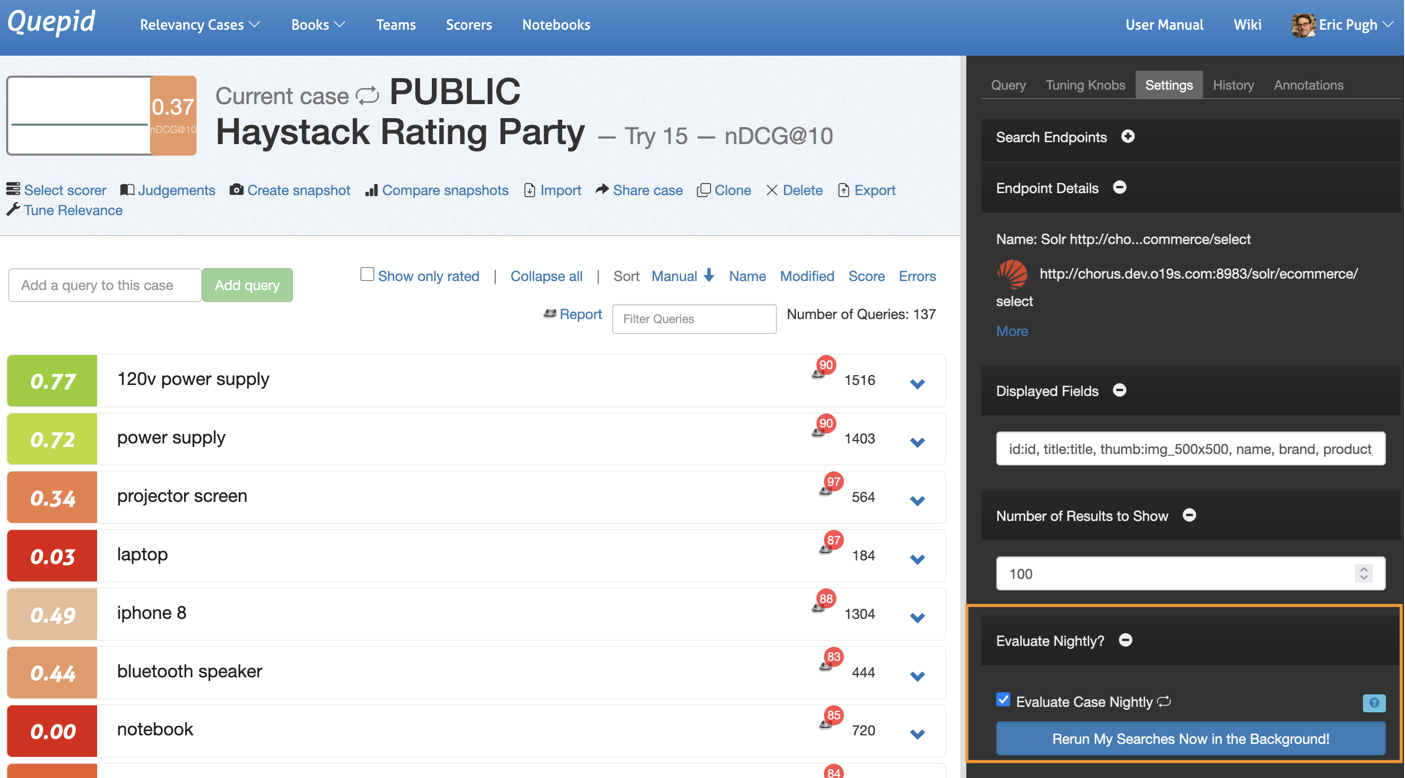
- Check box the icon and then you will see a "nightly looping" icon flip on next to the Case title:

- You can test if the case works in background mode by clicking Rerun My Searches Now in the Background button. This will pop you back to the homepage where you will see some messaging for the case that the queries are being run.
- The Case will be run every night. Each
How to Run a Case Nightly
198 words
 Move How to Connect Quepid to Elastic Cloud
Move How to Connect Quepid to Elastic Cloud
Open How to Connect Quepid to Elastic Cloud
Prerequisites
- You have an active Elastic Cloud account
- You have a deployment with a searchable index
This how to describes the three necessary processes to connect Quepid to your Elastic Cloud deployments:
- Configure Elastic Cloud deployment to accept browser requests from Quepid
- Create an API Key in Elastic Cloud
Connect Quepid to Elastic Cloud with the appropriate settings
Configure your Elastic Cloud deployment to accept browser requests from Quepid
Log into your Elastic Cloud account at https://cloud.elastic.co/home.
Select Manage next to the Deployment you want to connect Quepid to.

Under your deployment name select Edit.
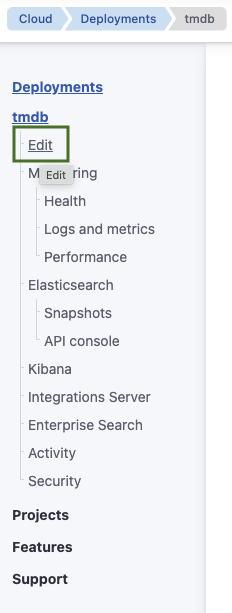
Select Manage user settings and extensions.
 Move How to Use Quepid's API
Move How to Use Quepid's API
Open How to Use Quepid's API
How to Use Quepid's API
Navigate to https://go.quepidapp.com/api/docs to see the documentation on the API and try it out
Accessing the Quepid API like http://localhost:3000/api/cases/5.json is protected by you logging in and having the appropriate cookies set.
But what if we want to have an automated process? Then you need to create a Personal Access Token.
Go to your Profile page and scroll down to the Personal Access Tokens section:

Click the Generate New Token and you will get a token that is specific to you that lets you interact with Quepid's API:
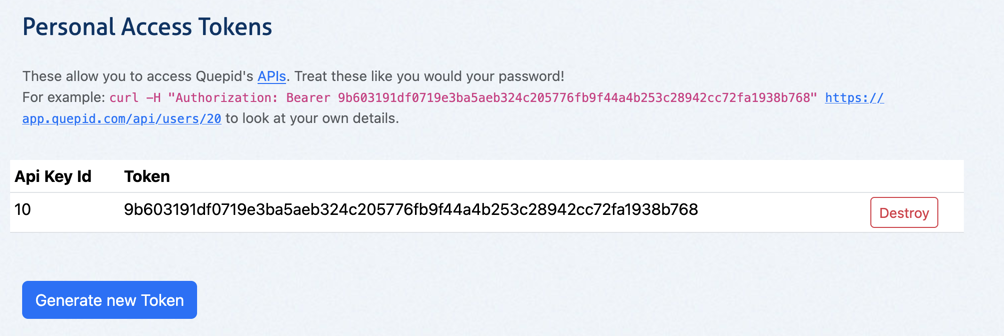
Here is an example of looking up information about a Case by it's id:
curl -X GET -H 'Authorization: Bearer 53e41835979d649775243ababd4312e8' http://localhost:3000/api/cases/5.json
>> {"name":"Book of Ratings","book_id":1,"query_doc_pairs":[{"query_doc_pair_id":1,"posi
How to Use Quepid's API
203 words
 Move How to Post Announcements to Users
Move How to Post Announcements to Users
Open How to Post Announcements to Users
How to Post Announcements to Users
Sometimes you need to communicate to your users, like the fact that a scorer has been changed or an end point has been updated. You can publish a new announcement to all users via the Announcements page.
You must be an Administrator and you access the page from the Admin pages:
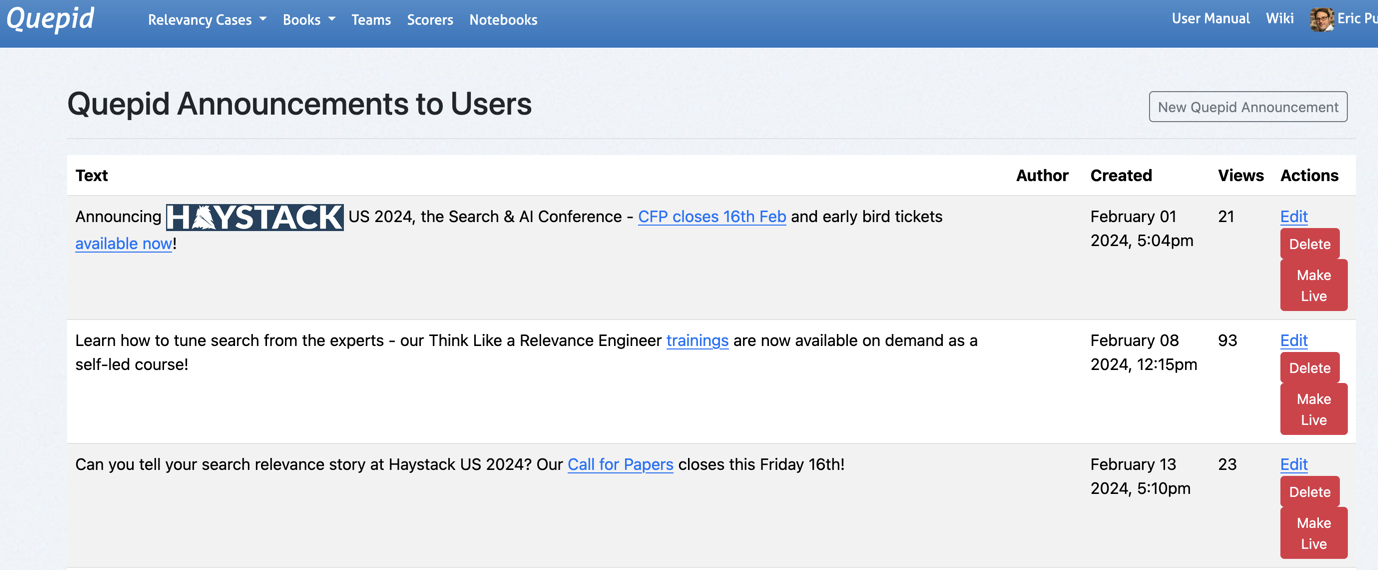
You can use emojis and HTML in the text, like this:
🎉 The program for <img src="https://haystackconf.com/img/logo.png" width="178" height="27"> has been launched!
Once they see it, they won't see it again.
You can only have one announcement live at a time, so users won't be bombarded by previous ones. Click Make Live to launch a new announcement and disable any currently live one.
How to Post Announcements to Users
124 words
 Move How to Integrate External Eval Pipeline
How to Integrate External Eval Pipeline
51 words
Move How to Integrate External Eval Pipeline
How to Integrate External Eval Pipeline
51 words
 Move How to Trouble Shoot Your Deploy
Move How to Trouble Shoot Your Deploy
Open How to Trouble Shoot Your Deploy
How to Trouble Shoot Your Deployment
When errors occur, Quepid logs them and shows a generic page.
However sometimes getting to those logs is difficult, and you just want the message immediately.
You can enable this behavior by setting the follow ENV var:
QUEPID_CONSIDER_ALL_REQUESTS_LOCAL=true
Confirm the setup by visiting /api/test_exception which raises an error and will give you the debugging page "RuntimeError in Api::ApiController#test_exception".
How to Trouble Shoot Your Deploy
67 words
 Move How to Use Ollama as LLM
Move How to Use Ollama as LLM
Open How to Use Ollama as LLM
How to Use Ollama as LLM
You can use Ollama hosted models instead of OpenAI as the LLM to power your AI Judges. This how to will walk you through the steps for configuring Quepid to talk to Ollama.
It assumes that you have deployed Quepid using Docker Compose and the docker-compose.yml that ships with Quepid. However, the general approach will work as well with any deployed Ollama server.
If you need to start the Ollama server then run docker compose up ollama. This starts an empty Ollama service.
Now let's download the smallest Qwen 2.5 model, which is just 398 MB, by running docker exec ollama ollama pull qwen2.5:0.5b.
Now you are ready to configure you AI Judge to use a local model.
Bring up your AI Judge editing screen:
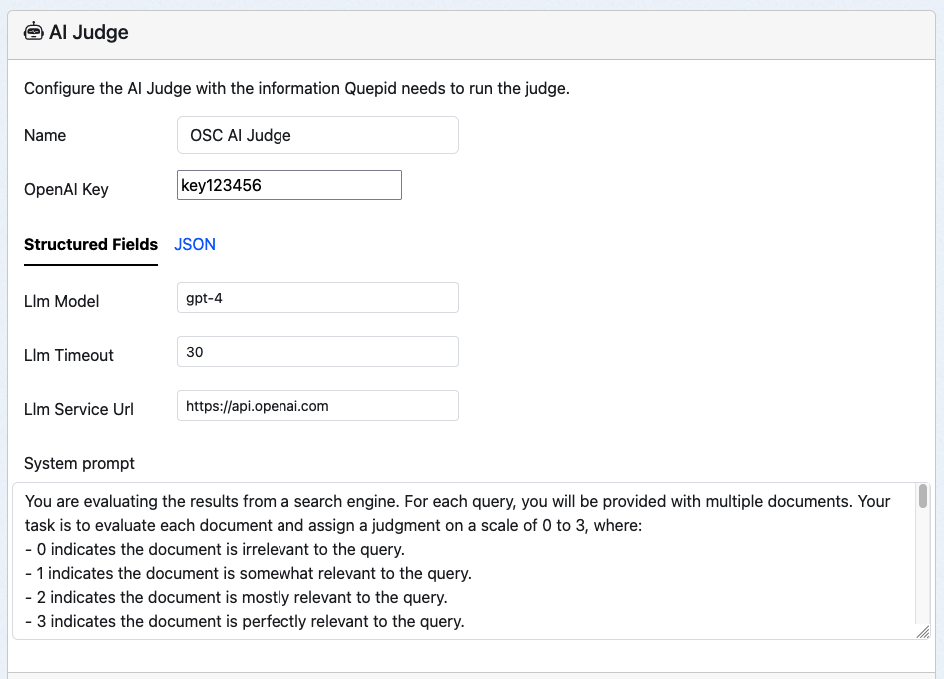
Make the following changes and save them. Local LLM models may run quite slowly, so having a long ti
How to Use Ollama as LLM
277 words
 Move Core Concepts
Move Core Concepts
Open Core Concepts
Core Concepts
First, let's walk through a few of the core concepts in Quepid.
Book: A book refers to a set of queries and documents and their ratings independent of the search engine. A single book can provide the source information for multiple cases.
Case: A case refers to all of the queries and relevance tuning settings for a single search engine. If you want to work with multiple instances of Solr or Elasticsearch (or any other search engine or API), you must create a separate case for each one.
Query: Within a case, queries are the keywords or other search criteria and their corresponding set of results that will be rated to determine the overall score of a case.
Rating: Ratings are the numerical values given to a result that indicates how relevant a particular search result is for the query. How each rating is interpreted depends on the scorer used for the query (or case), but usually the higher the number the more relevant the result is.
Result: Within a query
Core Concepts
378 words
 Move Quepid App Settings
Quepid App Settings
43 words
Move Quepid App Settings
Quepid App Settings
43 words
 Move Quick Start Wizard
Move Quick Start Wizard
Open Quick Start Wizard
Quick Start Wizard
The "Quick Start Wizard", which launches on first login or any time you create a new case, will guide you through configuring your Solr, Elasticsearch, or other search endpoint and setting up your case.
What you need to complete the wizard
- A Solr or Elasticsearch instance that is accessible from your browser
- A list of desired fields from your search engine
*Note: You can use the demo Solr or Elasticsearch instances provided to test Quepid
Naming Your Case
First you will be required to enter a case name. Select something descriptive to distinguish between your cases.
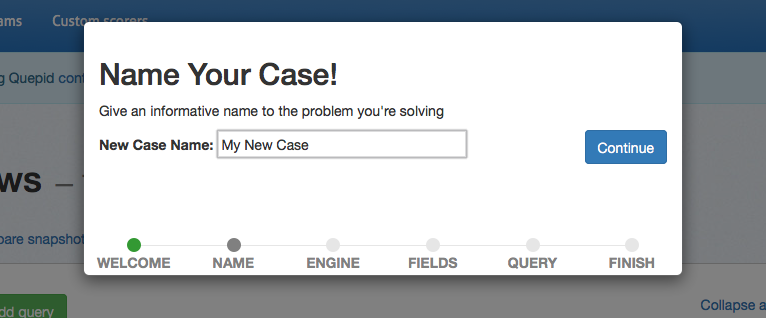
Connecting your Search Engine
Quepid does not require any installation on your server. All you need to do is indicate which search engine you are working with, and provide the URL to your search engine. A wide variety of search engines are supported.
You will be able to update this URL at any point in the s
Quick Start Wizard
409 words
 Move Case Screen
Move Case Screen
Open Case Screen
Case Screen
Now that we have the basic setup out of the way, let's take a look at the major elements of Quepid's Case screen.
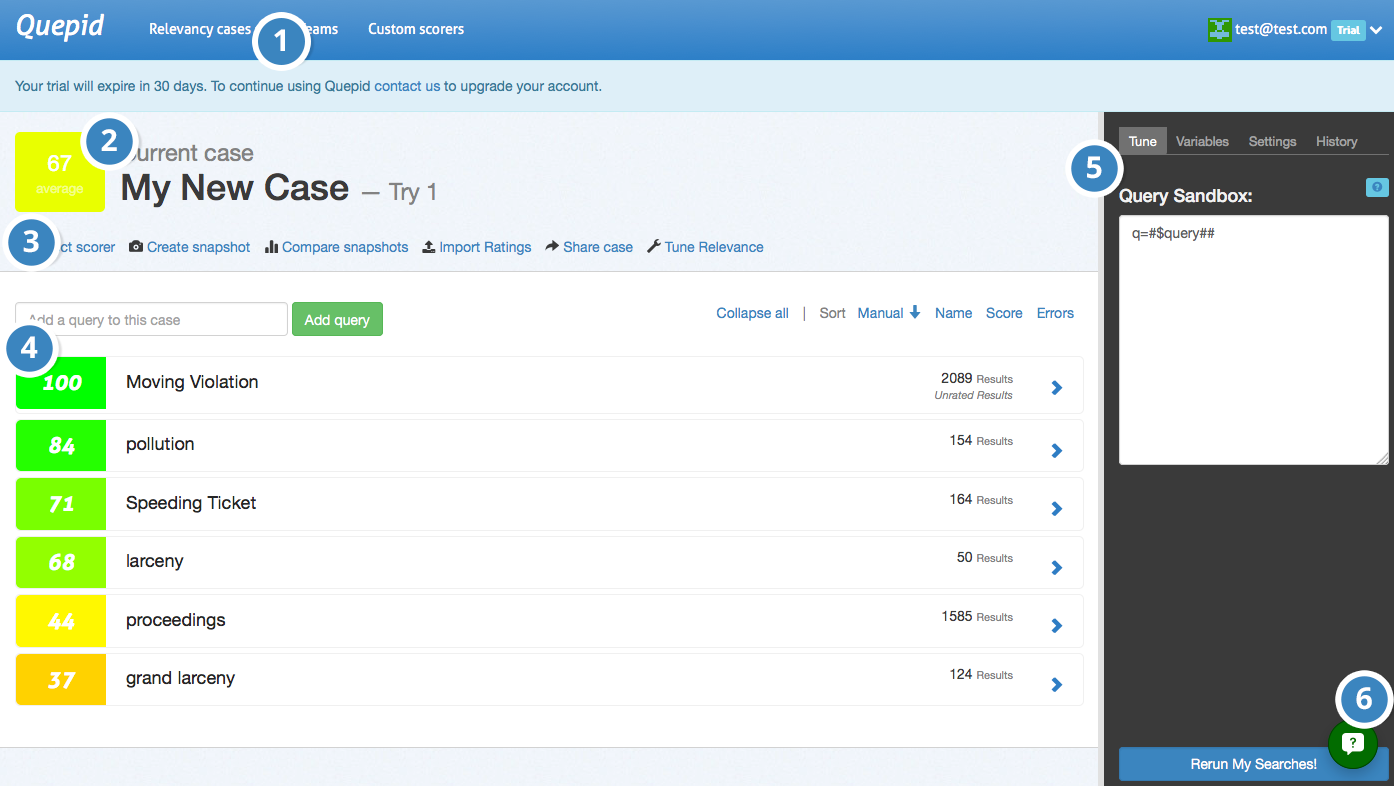
1. Relevancy Case Dropdown - Select or create cases to work on.
2. Case Information - Displays case summary including name, average query score, and current iteration in dashboard history.
3. Case Actions - Shows available actions including scorer selection, snapshot management, sharing options, and relevancy tuning panel toggle.
4. Queries -Add new queries and view existing ones. Click arrow to view and rate individual query results.
5. Relevancy Tuning Panel - Modify search relevancy settings and tune searches. Panel is closed by default and accessible via case actions.
6. Quepid Support - Access support chat window in bottom right corner for assistance from search relevancy experts.
Case Screen
134 words
 Move Managing your Query Set
Move Managing your Query Set
Open Managing your Query Set
Manage Your Queries
Adding Queries

Adding additional queries is simple. Just type in your search term(s) and click Add query and Quepid will populate the results. A newly added query will display an empty score, the title, and the number of results found. Click on the arrow to expand a single result:
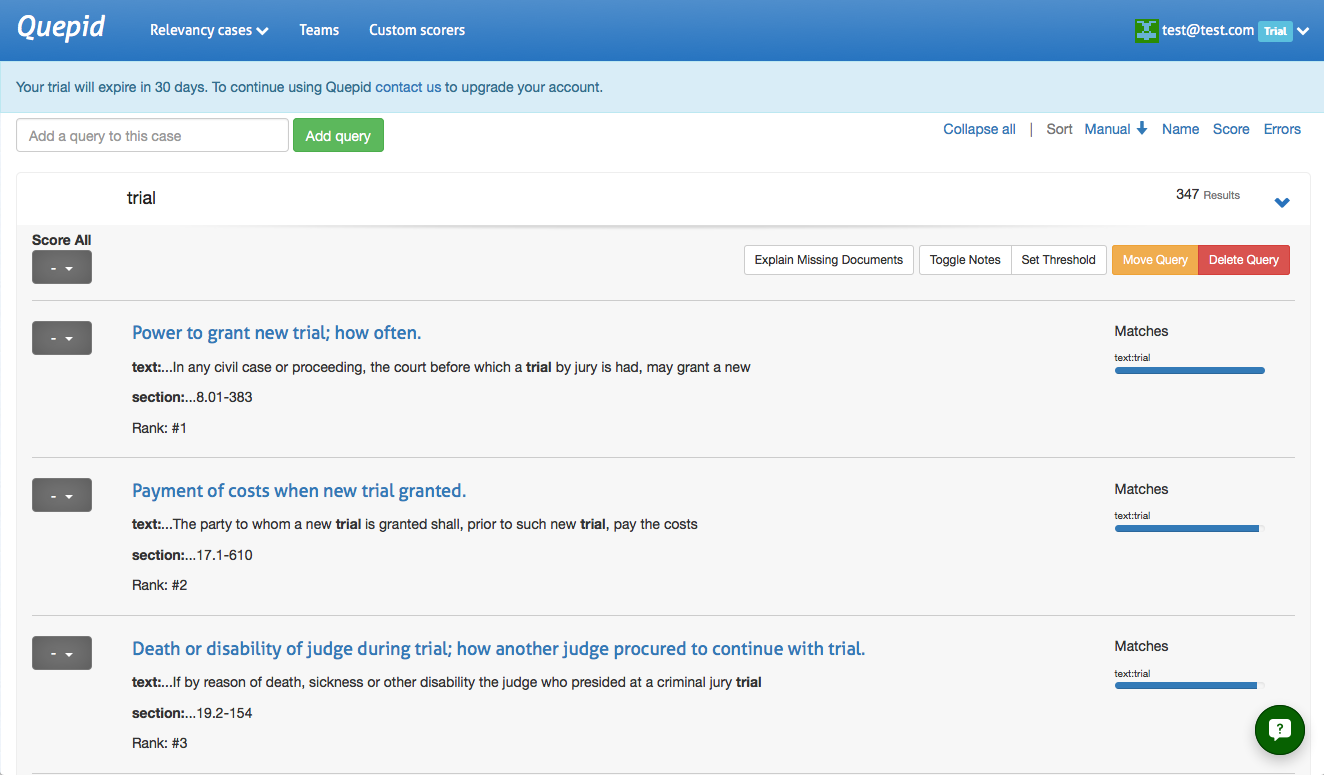
Want to add a number of queries all at once? Just separate them with a
;, like so: star wars;star trek and click Add query.
Rating Queries
Queries are rated through the dropdown to the left of each result. Clicking on the dropdown will bring up the rating scale based on the scorer you have selected.
If you haven't picked a specific scorer, then the Quepid system default scorer AP@10 will be used. It has a binary Irrelevant or Relevant choice.
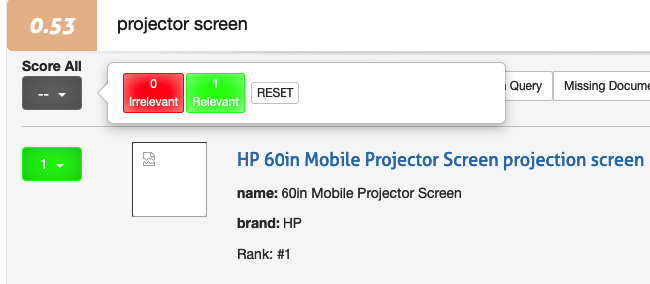
Managing your Query Set
596 words
 Move Relevance Panel
Move Relevance Panel
Open Relevance Panel
Relevance Panel
To modify your search settings, open the relevancy tuning panel by clicking the tune relevance link in the case actions area.
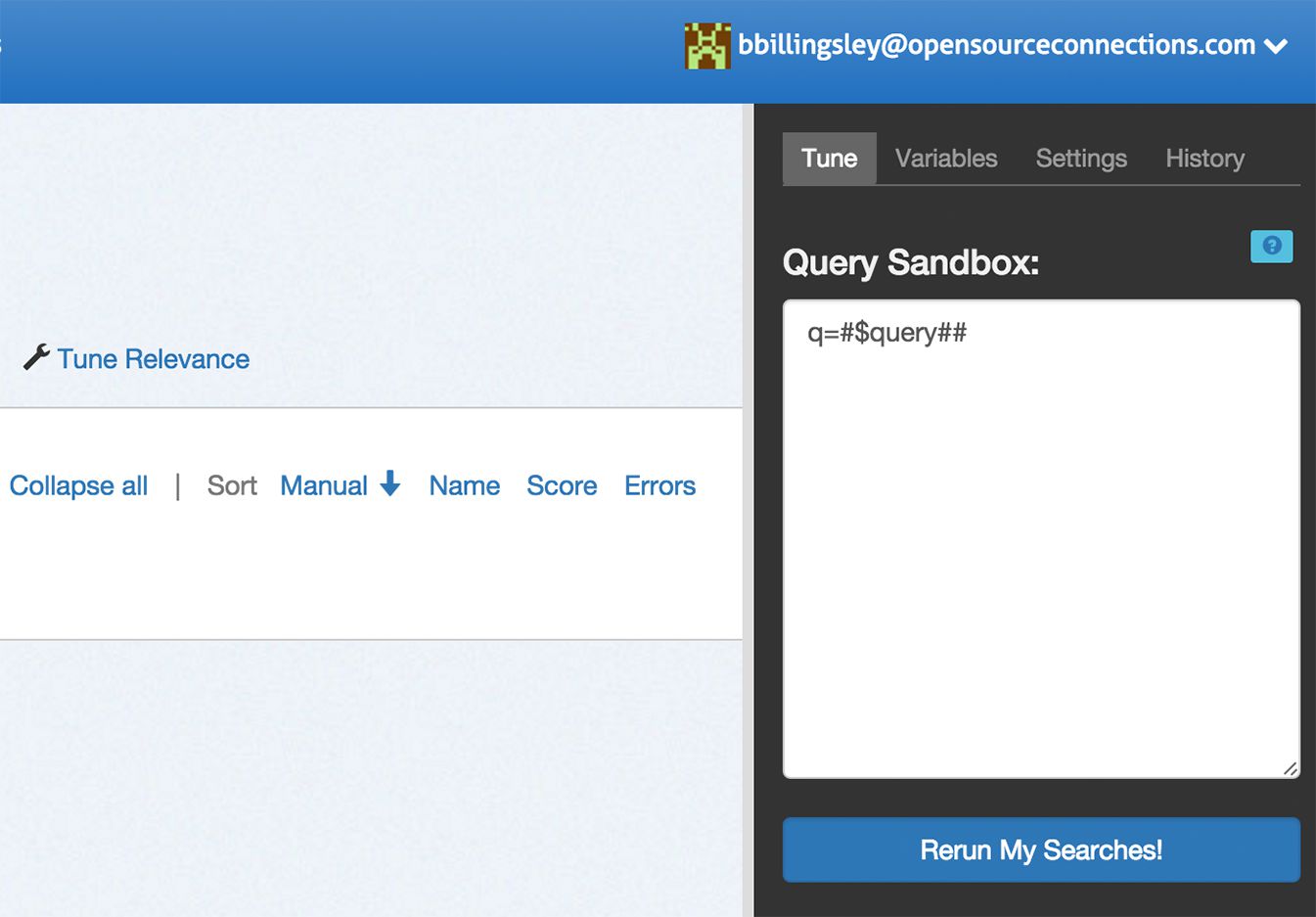
The default panel allows you to modify the Solr or Elasticsearch query
parameters directly. Update your query here and click Rerun my
searches to see the results update.
Magic Variables
"Magic variables" are placeholders. You can add a list of queries that Quepid will automatically run against your search engine. While you can specify which parameters are sent with the call, you need to know how to connect your query list to these parameters. This is where "magic variables" come in.
There are 3 types of "magic variables":
Query Magic Variable
The #$query## string represents the query variable. Quepid replaces this pattern with your full query. This is the simplest and most important "magic variable."
Example:
Let's say you have:
- A movies index using S
Relevance Panel
535 words
 Move Importing and Exporting Ratings
Move Importing and Exporting Ratings
Open Importing and Exporting Ratings
Importing ratings will override your existing ratings. Proceed with caution!
Ratings can be imported into existing queries and cases. You may want to import ratings if you have previously rated search results in another application other than Quepid. Ratings can be imported from CSV, Rated Ranking Evaluator, or in the common Learning To Rank (LTR) format. To import ratings, click the Import link. A window will be shown to begin the import.
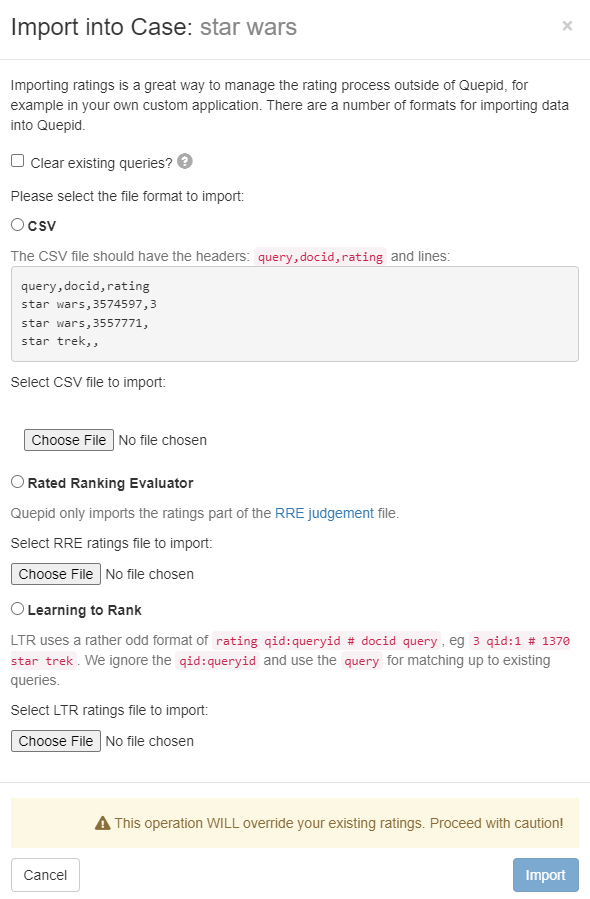
First, importing ratings can clear your existing queries. If all of your work has been done outside of Quepid and you are now bringing your work into Quepid you can select the Clear existing queries option to remove all queries from Quepid prior to the import. Please be sure you want to do this because all queries in Quepid will be lost.
Next, select the format of your ratings to import. Choose either CSV, Rated Ranking Evaluator, or
Importing and Exporting Ratings
283 words
 Move Managing Snapshots
Move Managing Snapshots
Open Managing Snapshots
Managing Snapshots
A important step in the benchmarking process for Quepid is taking
regular snapshots of your case over time and comparing them to ensure
that relevancy is improving.
Creating Snapshots
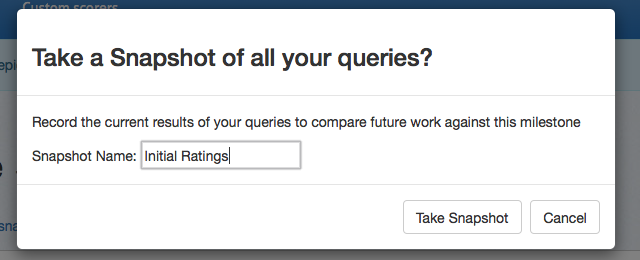
When you are ready to take a snapshot, click on Create Snapshot in the case actions area to bring up the snapshot dialog box. From here, give your snapshot a descriptive name and click Take Snapshot. The current ratings for all of your queries are now saved.
Comparing Snapshots
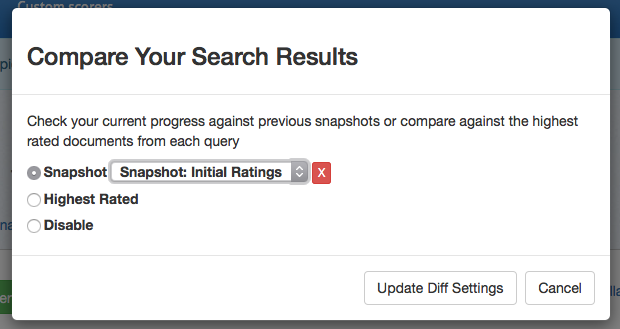
Once you have made improvements to your search relevancy settings, you will want to judge your improvement. Click on_"Compare snapshots_ to view your current results with a previous snapshot. You can now see the scores and results side-by-side for comparison.
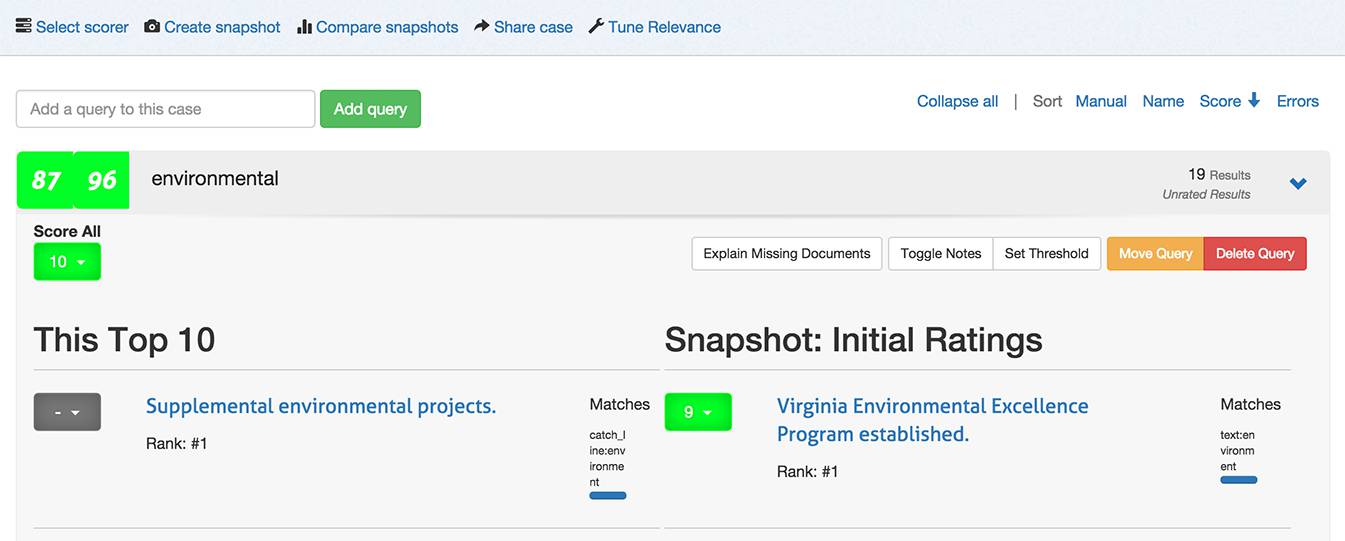
Managing Snapshots
126 words
 Move Managing Cases
Move Managing Cases
Open Managing Cases
Managing Cases
Also on the case dashboard, you can manage existing cases. You can see
both the cases you own and those that have been shared with you.
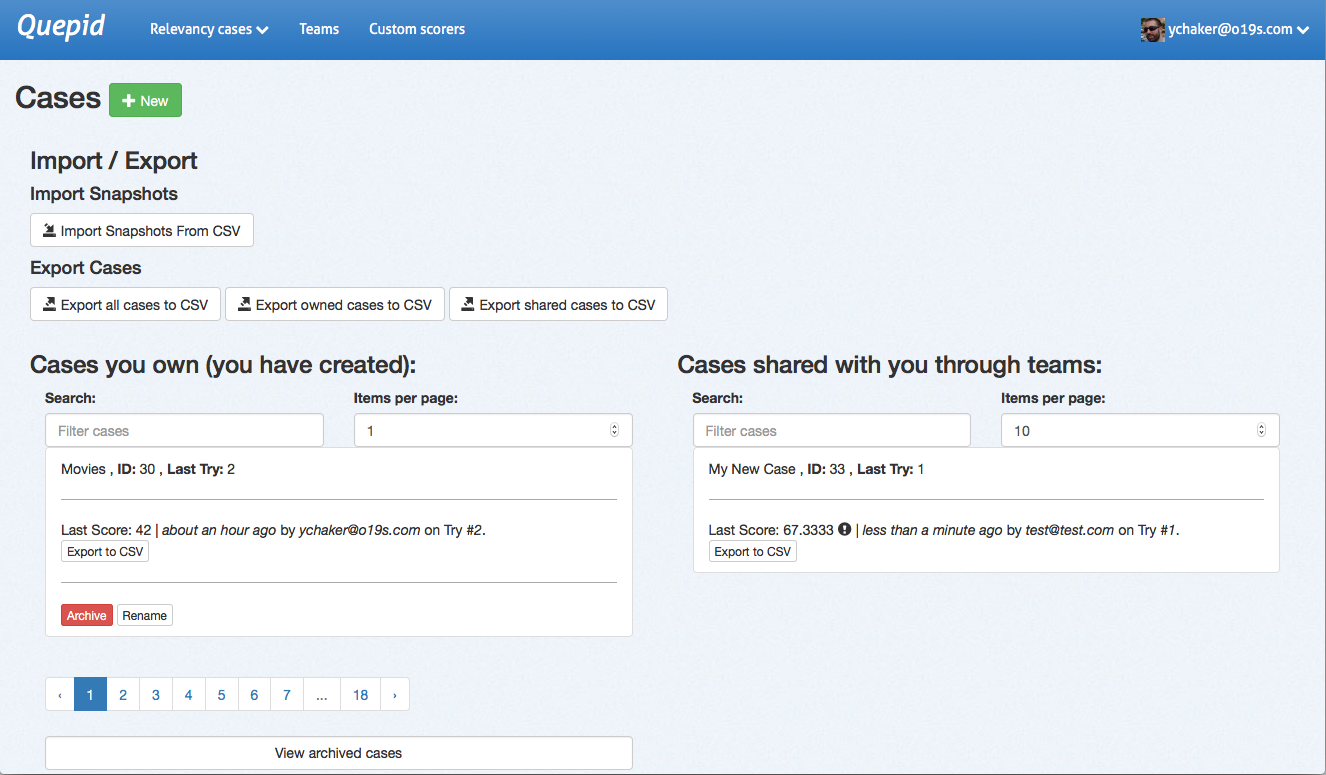
For each set of cases, you can filter the list by name and number of documents per page, and paginate through pages if needed. You can click on any case name to open it in the main Quepid dashboard.
Each case can be archived or renamed. Cases should be archived when no longer active, and you can access archived cases using the View archived cases link at the bottom of the page.
Managing Cases
102 words
 Move Manage Your Team
Move Manage Your Team
Open Manage Your Team
Manage Your Team
Teams in Quepid allow you to group your users based on their roles and cases. For example, you can create teams for your raters and your search relevance engineers as shown in the screenshot below. Case can be assigned to teams to provide access to your company's search team members. You can also make custom scorers available to a team. Using Quepid's Teams helps keep your search relevancy efforts organized. To access the Teams, click the Teams menu at the top of any page.
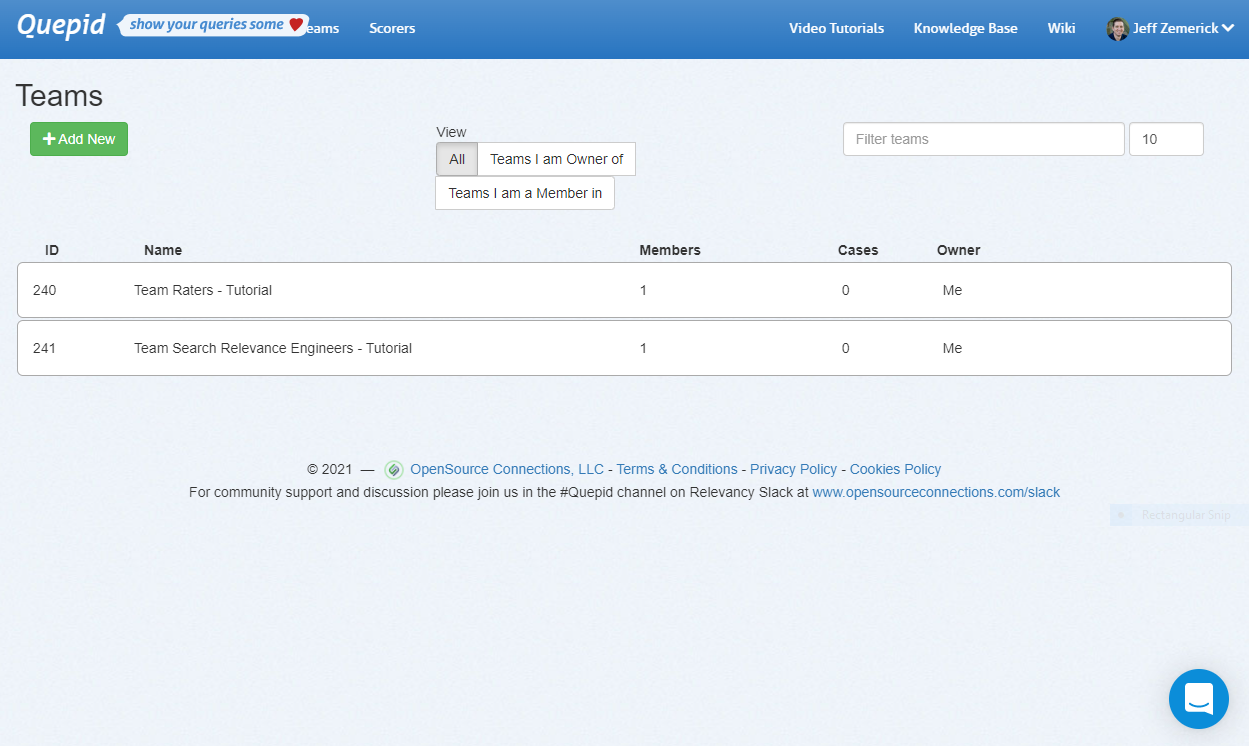
To create a team, click the Add New button. You will be asked to give the new team a name. All team names must be unique in each deployment of Quepid.
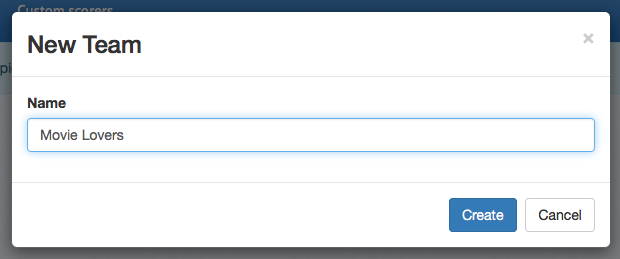
Creating a Team
To add users to a team, click the name of the desired team to open the team detail page. On this page, enter the user's email address or display name and click the Add User button.
 Move Managing Scorers
Move Managing Scorers
Open Managing Scorers
Managing Scorers
Scorers are run over all your queries to calculate how good the search results are according to the ratings you've made.
You can specify whatever scale you want, from binary (0 or 1) to graded (0 to 3 or 1 to 10) scales. Each scorer behaves differently depending on whether it handles graded versus binary scales.
Classical Scorers Shipped with Quepid
These are scorers that come with Quepid. k refers to the depth of search results evaluated. Learn more in our "Choosing Your Search Relevance Metric" blog post.
| Scorer |
Scale |
Description |
Precision P@10 |
binary (0 or 1) |
Precision measures the relevance of the entire results set. It is the fraction of the documents retrieved that are relevant to the user's information need. Precision is scoped to measure only the top k results. |
Average Precision AP@10 |
binary (0 or 1) |
Average Preci |
Managing Scorers
1,013 words
 Move Custom Scorers
Move Custom Scorers
Open Custom Scorers
Custom Scorers
Quepid comes with classic Information Retrieval Scorers, that we refer to as Communal scorers. Sometimes however you want your own Custom Scorer.
To access the scorers click the Scorers link at the top of any page.
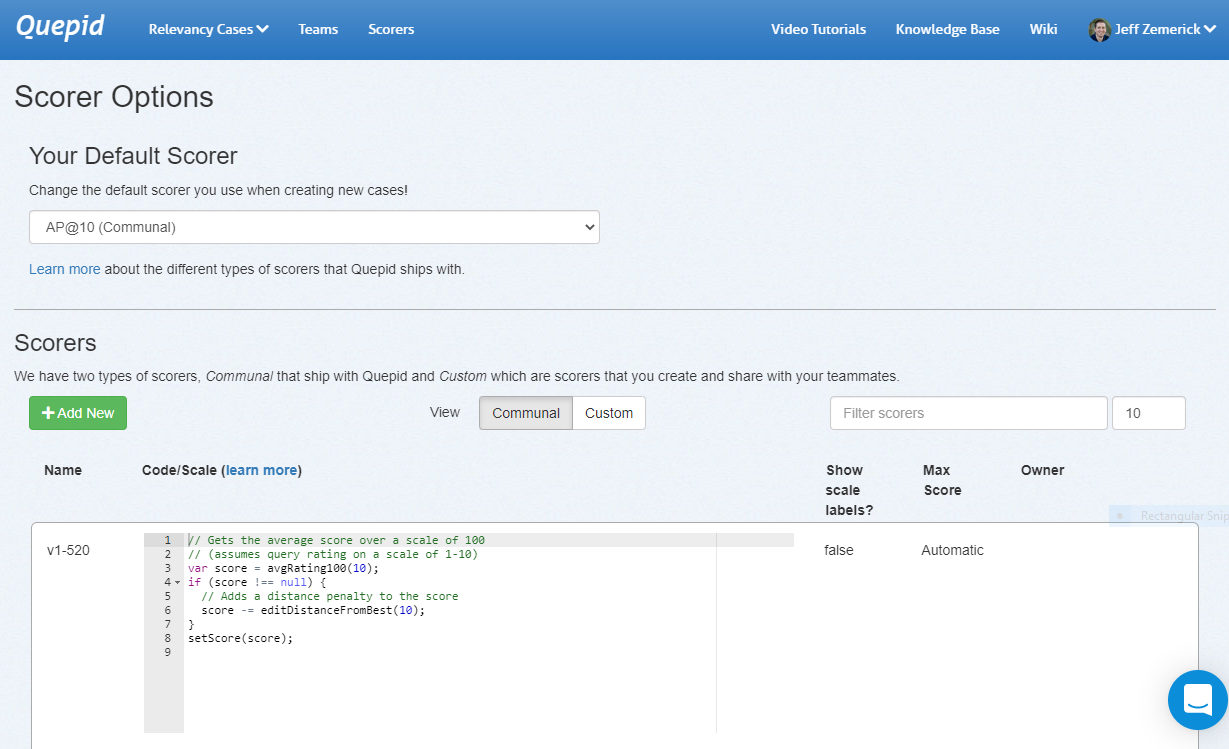
On the scorers page, click the Communal tab to show only the scorers that are available to all users of Quepid. Click the Custom tab to show only scorers that you have created and shared with a team. To create a new scorer, click the _Add New _button. The New Scorer window will be shown.
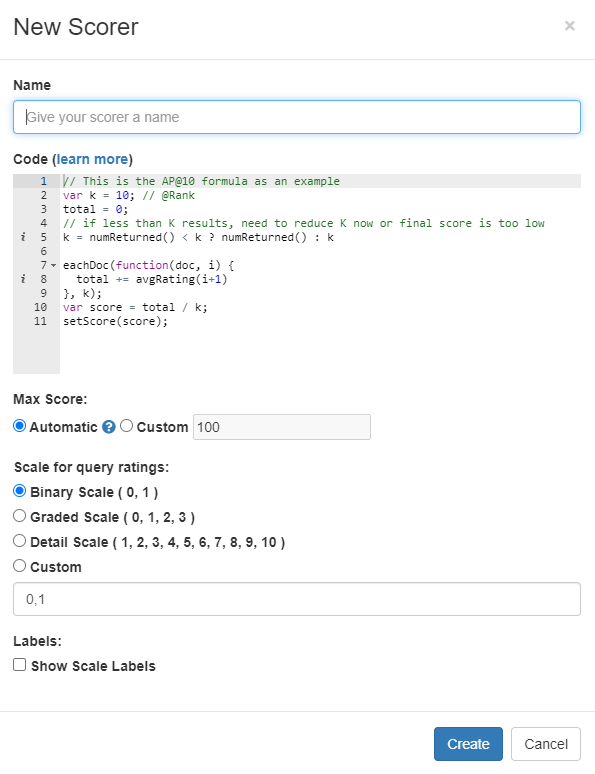
First, give your scorer a name. Next, you can enter the JavaScript code for your scorer. Refer to Creating a Custom Scorer to learn more about the code requirements. Next, choose the scale for the scorer. Finally, you can optionally provide labels for the scale by clicking the Show Scale Labels option. When fini
Custom Scorers
327 words
 Move API Documentation
Move API Documentation
Open API Documentation
Curious about the API's that Quepid exposes? Check out the documentation at https://go.quepidapp.com/api/docs.
Note: The generated docs are NOT comprehensive, and you may need to consult the source code or open up your web inspector to see the HTTP traffic to learn about other APIs.
Quepid's APIs enable you to automate processes and integrate Quepid with other products you or your company uses.
The APIs are REST-based. Responses are JSON, and errors are reported via standard HTTP codes in addition to JSON-formatted error information in the HTTP response bodies of relevant requests. We use Personal Access Token for authentication and authorization.
API Documentation
102 words
 Move Quepid Administration CLI aka Thor
Move Quepid Administration CLI aka Thor
Open Quepid Administration CLI aka Thor
Quepid Adminstration CLI aka Thor
This CLI tool that you run on the Quepid application lets you script out many processes.
The see available tasks:
docker compose run app bundle exec thor list
Examples include:
case
----
thor case:create NAME SEARCH_ENGINE ENDPOINT_URL API_METHOD FIELD_SPEC QUERY_PARAMS SCORER_NAME OWNER_EMAIL # creates a new case
thor case:load_the_haystack_rating_snapshots # load the haystack rating party data
thor case:share CASEID TEAMID # shares case with an team
ratings
-------
thor ratings:generate SOLRURL FILENAME # generates random ratings into a .csv file
thor ratings:import CASEID FILENAME # imports ratings to a case
sample_data
-----------
thor sample_data:haystack_party # load the haystack rating party data
thor sample_data:large_data # load the very large sample data
thor sample
Quepid Administration CLI aka Thor
362 words
 Move How Many Queries and Documents Do I need?
Move How Many Queries and Documents Do I need?
Open How Many Queries and Documents Do I need?
How Many Queries and Documents Do I need?
How many search results should be judged?
The number of search results you should judge depends on a few factors and your organization's search team can provide guidance. As a general rule of thumb, 100 judgments (10 pages of 10 search results) is a good starting point and likely sufficient for most cases.
You may have noticed the frog icons? The backstory is that we needed an icon to call attention to some queries having unrated documents. Eric's son Asher loves frogs, and when Asher was asked to pick an icon, he picked the frog one! So, we talk about "chasing the frogs" to mean getting rid of unrated documents. The more frogs you have, the less confidence you have in accurate search metrics.
You can click the Frog Pond report link to get a sense of how many ratings you need.
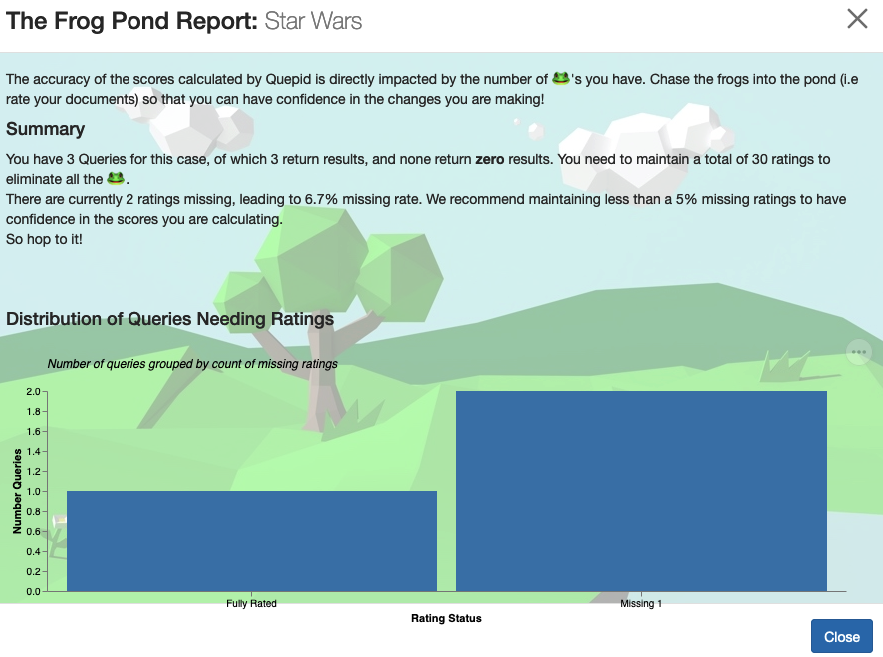
Over time you can figure out how many ratings you need to do per week
How Many Queries and Documents Do I need?
174 words
 Move Using Notebooks for Analytics
Move Using Notebooks for Analytics
Open Using Notebooks for Analytics
Using Notebooks for Analytics
Data scientists are gonna data science... - Eric
At some point, you decide you want to dig into the data collected by Quepid to do more advanced analytics. Maybe you are curious about Inter Rater Reliablity? Or you want to do some deeper comparison between Cases or Snapshots such as Jaccard comparison? This is what the Notebooks interface is for.
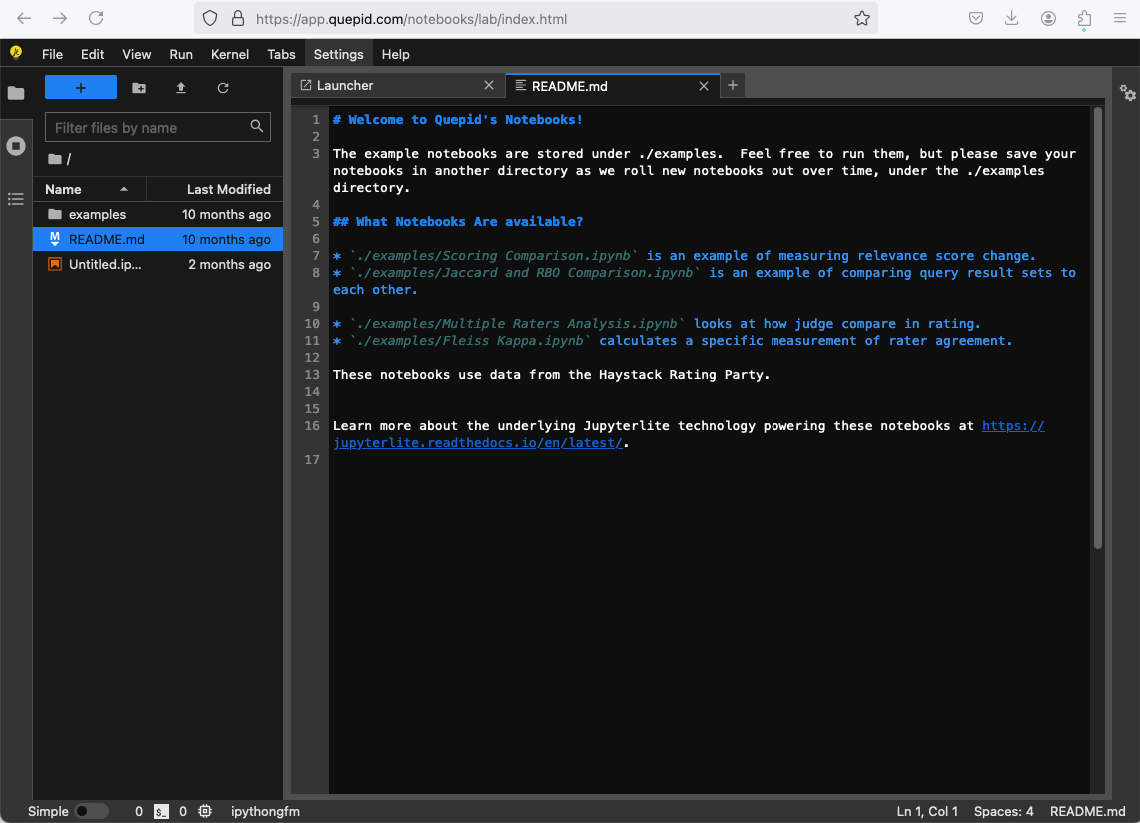
Quepid ships with some example Jupyter notebooks that are meant as starting points for analyzing data. Each notebook is runnable, they all leverage a public dataset to demonstrate how they work. You can just click the double arrow play button to rerun them. Note, the first time you run the notebooks it takes a bit to load dependencies, and then they run quickly.
To use them, right click on the example notebook and copy it to your own file that is outside the /examples directory. Otherwise you may lose your customization
Using Notebooks for Analytics
478 words
 Move How to Integrate Quepid Into Your Eval Workflow
Move How to Integrate Quepid Into Your Eval Workflow
Open How to Integrate Quepid Into Your Eval Workflow
How to Integrate Quepid Into Your Eval Workflow
Do you already have an Search Evaluation workflow in place, or parts of it that you want to preserve, but also take advantage of Quepid? There are three main approaches, from least itnegrated to most integrated:
- Export/Import Data Files between your existing solution and Quepid
- Leverage Quepid's APIs to integrate Quepid into your existing solution
- Wrap Quepid's data model directly into your solution
Export/Import Data Files between your existing solution and Quepid
Do you already have a fairly robust mature solution for doing Search Evaluation? Something homegrown, or maybe you are invested in OpenSearch's "Search Relevance Workbench"? Or you have been using SearchTweak?
Quepid supports exporting and importing data via CSV and JSON formats for almost all of the major data structures (Books, Cases, Users, Queries, Judgements). Yes, you will have to do some data format conversions, and it's a manual integration, but it's also s
How to Integrate Quepid Into Your Eval Workflow
420 words
 Move How LLM as a Judge Works
Move How LLM as a Judge Works
Open How LLM as a Judge Works
How LLM as a Judge Works
When you attach the AI Judge to a book in Quepid, it automatically sends evaluation requests to the OpenAI API using both your custom prompt and the query/document pair data.
Each request uses a prompt template that you configure in the AI Judge settings. This prompt is dynamically populated with the fields from each query/document pair, allowing the model to evaluate results in context.
Request Structure
Quepid uses OpenAI's chat completion API, which requires a messages array to simulate a conversation. For each document/query pair, the following structure is generated:
[
{
"role": "system",
"content": "<your AI judge prompt>"
},
{
"role": "user",
"content": [
{
"type": "text",
"text": "<textual query/document pair data>"
}
]
}
]
How Images are used in Evaluation
If your document contains a field named image, or if any field is explicitly tagged with image:, Quepid hand
How LLM as a Judge Works
242 words